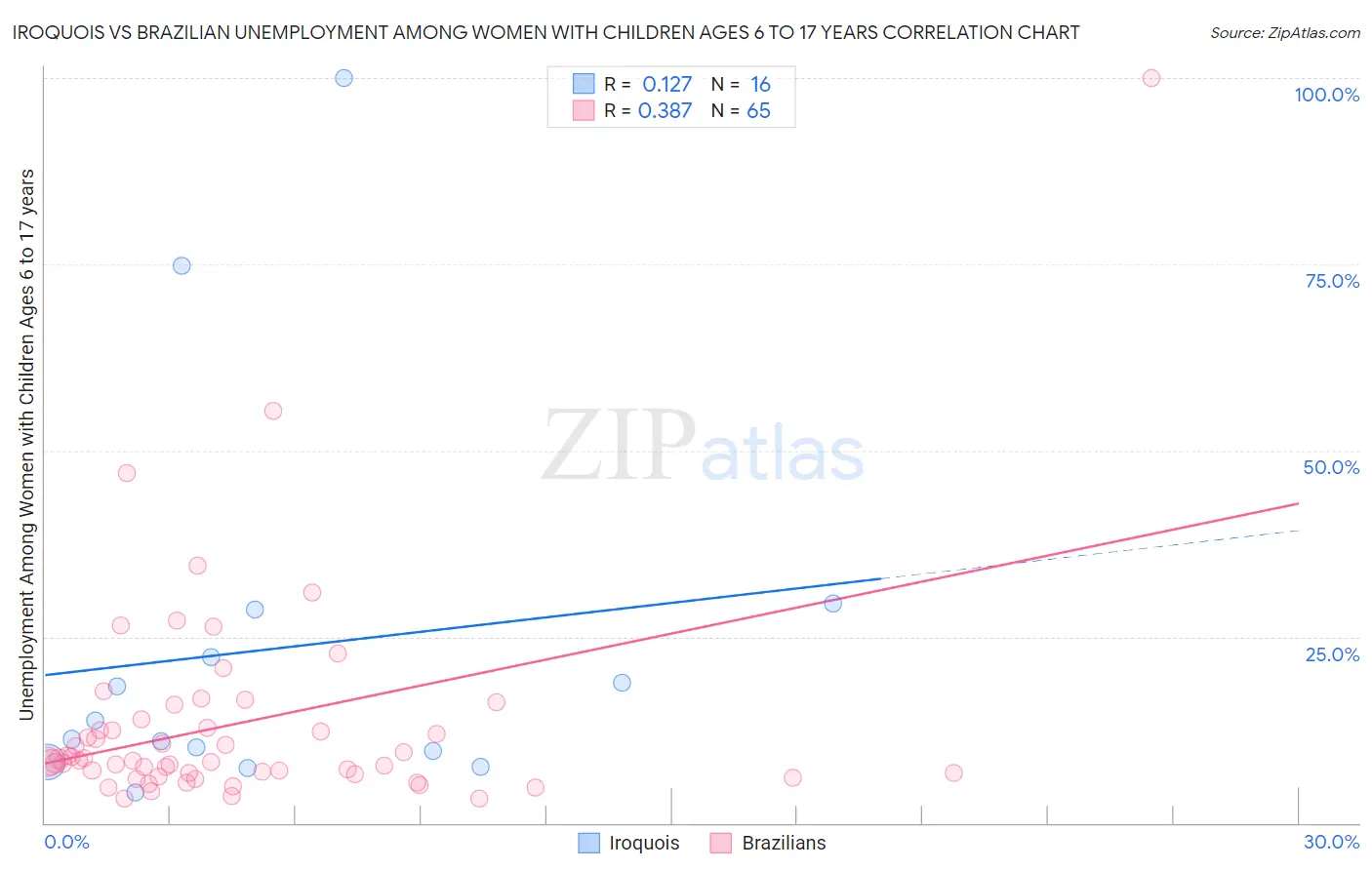Iroquois vs Brazilian Unemployment Among Women with Children Ages 6 to 17 years
COMPARE
Iroquois
Brazilian
Unemployment Among Women with Children Ages 6 to 17 years
Unemployment Among Women with Children Ages 6 to 17 years Comparison
Iroquois
Brazilians
9.2%
UNEMPLOYMENT AMONG WOMEN WITH CHILDREN AGES 6 TO 17 YEARS
7.5/ 100
METRIC RATING
214th/ 347
METRIC RANK
9.1%
UNEMPLOYMENT AMONG WOMEN WITH CHILDREN AGES 6 TO 17 YEARS
24.4/ 100
METRIC RATING
196th/ 347
METRIC RANK
Iroquois vs Brazilian Unemployment Among Women with Children Ages 6 to 17 years Correlation Chart
The statistical analysis conducted on geographies consisting of 161,290,080 people shows a poor positive correlation between the proportion of Iroquois and unemployment rate among women with children between the ages 6 and 17 in the United States with a correlation coefficient (R) of 0.127 and weighted average of 9.2%. Similarly, the statistical analysis conducted on geographies consisting of 240,779,171 people shows a mild positive correlation between the proportion of Brazilians and unemployment rate among women with children between the ages 6 and 17 in the United States with a correlation coefficient (R) of 0.387 and weighted average of 9.1%, a difference of 1.5%.

Unemployment Among Women with Children Ages 6 to 17 years Correlation Summary
| Measurement | Iroquois | Brazilian |
| Minimum | 4.0% | 3.3% |
| Maximum | 100.0% | 100.0% |
| Range | 96.0% | 96.7% |
| Mean | 23.4% | 13.3% |
| Median | 12.5% | 8.4% |
| Interquartile 25% (IQ1) | 8.9% | 6.7% |
| Interquartile 75% (IQ3) | 25.4% | 13.3% |
| Interquartile Range (IQR) | 16.5% | 6.7% |
| Standard Deviation (Sample) | 26.5% | 14.7% |
| Standard Deviation (Population) | 25.6% | 14.5% |
Demographics Similar to Iroquois and Brazilians by Unemployment Among Women with Children Ages 6 to 17 years
In terms of unemployment among women with children ages 6 to 17 years, the demographic groups most similar to Iroquois are Immigrants from Germany (9.2%, a difference of 0.040%), Spaniard (9.2%, a difference of 0.10%), Peruvian (9.2%, a difference of 0.21%), Immigrants from Cuba (9.2%, a difference of 0.29%), and Finnish (9.2%, a difference of 0.34%). Similarly, the demographic groups most similar to Brazilians are Immigrants from Panama (9.1%, a difference of 0.010%), Austrian (9.1%, a difference of 0.030%), Guyanese (9.1%, a difference of 0.16%), Czechoslovakian (9.1%, a difference of 0.23%), and Trinidadian and Tobagonian (9.1%, a difference of 0.41%).
| Demographics | Rating | Rank | Unemployment Among Women with Children Ages 6 to 17 years |
| Austrians | 25.0 /100 | #195 | Fair 9.1% |
| Brazilians | 24.4 /100 | #196 | Fair 9.1% |
| Immigrants | Panama | 24.3 /100 | #197 | Fair 9.1% |
| Guyanese | 21.8 /100 | #198 | Fair 9.1% |
| Czechoslovakians | 20.8 /100 | #199 | Fair 9.1% |
| Trinidadians and Tobagonians | 18.2 /100 | #200 | Poor 9.1% |
| Immigrants | Trinidad and Tobago | 16.7 /100 | #201 | Poor 9.1% |
| Immigrants | Middle Africa | 15.6 /100 | #202 | Poor 9.1% |
| Maltese | 15.3 /100 | #203 | Poor 9.1% |
| Immigrants | Canada | 15.3 /100 | #204 | Poor 9.1% |
| Immigrants | Western Europe | 14.1 /100 | #205 | Poor 9.1% |
| Immigrants | North America | 12.7 /100 | #206 | Poor 9.2% |
| Cubans | 10.9 /100 | #207 | Poor 9.2% |
| Immigrants | Peru | 10.8 /100 | #208 | Poor 9.2% |
| Salvadorans | 10.7 /100 | #209 | Poor 9.2% |
| Finns | 10.0 /100 | #210 | Tragic 9.2% |
| Immigrants | Cuba | 9.6 /100 | #211 | Tragic 9.2% |
| Peruvians | 9.0 /100 | #212 | Tragic 9.2% |
| Spaniards | 8.2 /100 | #213 | Tragic 9.2% |
| Iroquois | 7.5 /100 | #214 | Tragic 9.2% |
| Immigrants | Germany | 7.2 /100 | #215 | Tragic 9.2% |